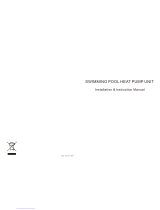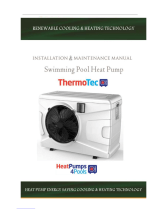
EvoHeat Advanced DHP-R Manual
Contents
1. Introduction _________________________________________________________________________________________ 2
2. Unit Dimensions ______________________________________________________________________________________ 3
3. Quick Start Guide _____________________________________________________________________________________ 4
4. Safety Instructions ____________________________________________________________________________________ 6
5. Installation __________________________________________________________________________________________ 6
5.1 Installation Introduction _____________________________________________________________________________ 6
5.2 Heater Condition __________________________________________________________________________________ 7
5.3 Location Recommendations __________________________________________________________________________ 7
5.4 Airflow Clearances _________________________________________________________________________________ 8
5.5 Adequate Water Flow _______________________________________________________________________________ 8
5.6 Rubber Feet ______________________________________________________________________________________ 9
5.7 Condensate Drain Barb ______________________________________________________________________________ 9
5.8 Drainage & Condensation ____________________________________________________________________________ 9
5.9 Plumbing _________________________________________________________________________________________ 9
5.10 Electrical Connection _____________________________________________________________________________ 10
5.11 Initial Start-up ___________________________________________________________________________________ 10
6. Operation __________________________________________________________________________________________ 11
6.1 Main Controller Interface ___________________________________________________________________________ 11
6.2 Functions of the Controller __________________________________________________________________________ 11
6.2.1 Start-up & Shut-Down __________________________________________________________________________ 11
6.2.2 Switching Modes & Setting the Target Temperature __________________________________________________ 11
6.2.3 Clock Settings ________________________________________________________________________________ 12
6.2.4 Silent Setting & Silent Timing ____________________________________________________________________ 12
6.2.5 Fault History _________________________________________________________________________________ 13
6.2.6 Colour Display Calibration _______________________________________________________________________ 13
7. Troubleshooting _____________________________________________________________________________________ 14
7.1 Parameter List & Breakdown Table ___________________________________________________________________ 14
7.1.1 Electronic Control Fault Table ____________________________________________________________________ 14
7
.1.2 Frequency Conversion Board Fault Table ___________________________________________________________ 15
7.1.3 Parameter List ________________________________________________________________________________ 16
7.2 Interface Drawing _________________________________________________________________________________ 16
7.2.1 Wire Control Interface Diagram and Definition ______________________________________________________ 16
8. Appendix ___________________________________________________________________________________________ 17
8.1 Controller Interface Diagram & Definition ______________________________________________________________ 17
8.2 PCB Description __________________________________________________________________________________ 18
8.3 Cable Specifications _______________________________________________________________________________ 20
9. Maintenance ________________________________________________________________________________________ 21
10. Warranty __________________________________________________________________________________________ 22
10.1 Warranty Registration ____________________________________________________________________________ 22






















